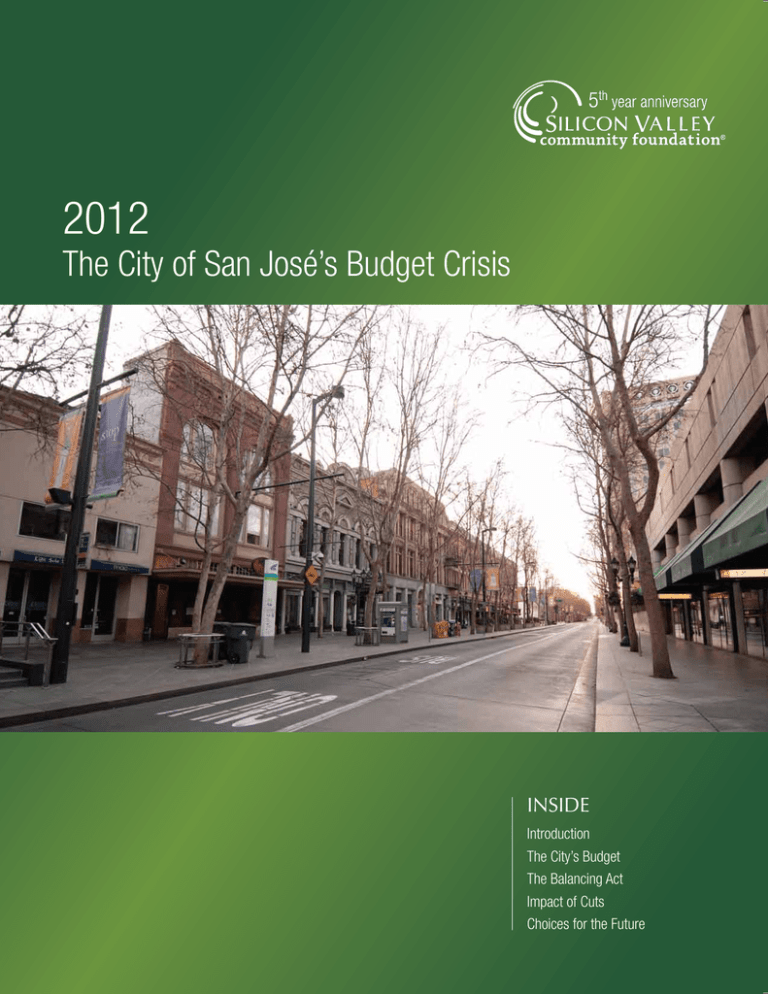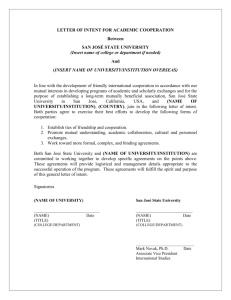The City of San José`s Budget Crisis
advertisement

2012 The City of San José’s Budget Crisis INSIDE Introduction The City’s Budget The Balancing Act Impact of Cuts Choices for the Future Introduction San José faces significant challenges in financing its future and continuing to meet its mandate to provide services to its residents. Pressures of a struggling housing market, sluggish consumer spending and high levels of unemployment are strangling growth in revenue. At the same time, the city faces ballooning employee retirement benefits and health-care costs. Service cuts alone are unlikely to solve the current problem. Significant reform must be considered – reform in the pension system, in ways of governing, in ways of engaging the citizenry. To design these reforms, we must raise questions and seek answers about the contract the city has with its residents. What services do people expect from their government and what are they willing to pay for those services? Silicon Valley Community Foundation has developed this fact sheet in hopes of creating common ground, based on reliable facts, to encourage honest dialogue. We are aware of the upcoming state audit and the controversy over projected pension payouts, but we believe that the city’s budgetary problems stem from deeply rooted structural imbalances between expenditures and revenues that warrant careful examination. There is much at stake here for the city, the county and Silicon Valley. Join us and other community members in seeking effective, equitable and long-term solutions. The City’s Budget San José is Northern California’s largest city with a population of nearly one million people spread over 180 square miles. Over the past 40 years, the city has doubled in size and grown increasingly diverse. Today, San José residents speak 56 different languages and nearly 40 percent were born outside the United States. Like many cities across California and the nation, San José has been experiencing multi-million-dollar budget shortfalls in recent years. However, San José’s budget troubles go back a decade, preceding the current downturn. Over that time, the growth in city expenses has outpaced the growth in revenues. As Figure 2 shows, 61 percent of the city’s general-fund expenditures go toward public safety (fire and police services) and community services (libraries, parks, etc.), things that directly impact the city’s residents. The remaining 39 percent pays for essential services that may not be as visible, such as workers’ compensation payments, convention center lease payments and replacement of fire equipment. Figure 2: General Fund Expenditures (FY 2011-12 adopted budget) Non-Departmental Capital Maintenance The city’s budget is comprised of the general fund and a number of smaller capital funds and special-purpose funds. The capital and special-purpose funds are restricted for specific uses, while the general fund is the source for most of the city’s day-to-day operations. Therefore, this fact sheet focuses on the general fund. There are several sources of revenue for the city’s general fund (see Figure 1). Property and sales taxes are the primary sources, but the city only receives a small percentage of the total tax collected: 9 percent of the property taxes and 12 percent of the sales tax. For example, a San José resident who owns a home assessed at $450,000 pays about $4,500 in annual property tax. However, the city only receives about $405 of that property tax. If that resident buys a $1,000 computer, she pays 8.25 percent sales tax or $82.50, but San José only receives $10 of that sales tax. Figure 1: General Fund Revenues (FY 2011-12 adopted budget) 6% Community Services 9% Other Agencies Transfers & Reimbursements 26% 7% 9% The city’s charter requires that the city council approve a balanced budget each year by June 30. The current community-based budget process takes nine months (see Figure 3) and there are several points for public input. Figure 3: Timetable for FY 2012-13 Budget October/ November Public release of early budget forecast and city council review of that forecast. January Community budget survey conducted. Public meeting held at which neighborhood leaders and youth commissioners set priorities. City staff reviews financial and service results for prior year. March Mayor’s March budget message outlines general direction for the year. May City manager presents proposed budget to city council. City council holds multiple public study sessions and community meetings in each city council district to receive public input. June City councilmembers submit budget requests to the mayor. The mayor delivers June budget message. Utility Taxes & Franchise Fees June 30 The city council votes to adopt a final budget. 19% 17% Sales Tax 11% Public Safety Property Tax 13% 8% 50% Other Licenses, Permits & Fees General Government 25% The Balancing Act San José has experienced general-fund budget shortfalls over the past decade driven by escalating costs and diminishing revenues. Those shortfalls have been exacerbated by two deep national recessions. These deficits result from structural imbalances that continue year after year and require systemic solutions. -28% -40% Employee costs started to increase during the Internet boom in the mid-1990s when city revenues were growing rapidly. The city boosted $72 7453 7418 7213 7000 6787 6672 $97 S50 S0 employee compensation to compete with privatesector jobs. Unfortunately, various successive city councils – and in some cases, outside arbitrators – continued to increase pay and benefits at a rate that the city could not afford when revenue growth began to slow. Following the lead of the State of California, the city council and outside arbitrators also significantly enhanced retirement benefits. The maximum benefit for public-safety employees (after 30 years of service) grew from 75 percent of final salary to 90 percent and a guaranteed 3 percent annual compounded cost-of-living adjustment was awarded to all employees. While both employees and the city make deposits into the retirement funds, the city currently contributes more than three-quarters of the total cost. As a result, the city’s annual retirement contribution has grown from $73 million to $244 million over the past 10 years (see Figure 5). Retirement costs now exceed more than 50 percent of base payroll costs.3 Figure 6: Change in Number of City’s Full-Time Equivalents5 8000 $96 6843 6992 6985 6623 5840 6000 5400 5000 4000 3000 2000 1000 0 -12 11 20 Average Cost per Employee $70 -11 10 20 General Revenue -20% $135 -10 09 20 # of Employees $136 -09 08 20 0% 19% $73 -08 07 20 20% $100 -07 06 20 40% $133 $117 -06 05 20 60% $150 -05 04 20 85% 80% $186 -04 03 20 100% $200 -03 02 20 Figure 4: Rise in Per Employee Costs (FY 2001-02 – FY 2011-12)1 $244 $250 -02 01 20 There are three ways to balance a budget: increase revenues, cut costs or do a combination of both. Cities raise revenue through fees, taxes and grants from state and federal agencies, but their ability to increase these sources is seriously limited. They cut expenses by deferring services, reducing staffing (through layoffs, hour reductions or attrition), increasing efficiencies, reforming systems or cutting services. San José’s leadership has used a combination of revenueenhancing and cost-cutting strategies to address shortfalls over the past decade, but has not been able to contain the primary driver of continuing shortfalls: rapidly escalating costs per employee (see Figure 4). Figure 5: City Contributions for Pension and Retiree Health Care Costs (in millions)2 The growing costs of health care benefits have added additional financial burdens. For example, the monthly premium for the city’s lowest cost family-health plan has nearly tripled over the past 10 years.4 These pay and benefit increases have proven unsustainable. In 2010 and 2011, all San José employees made concessions, including a 10 percent cut in total compensation, to help close the revenue/expense gap; services were cut and employees laid off as the city closed the two largest shortfalls in its history ($118.5 million in 2010-2011 and $115 million in 2011-2012). Over the past decade, the city has eliminated close to 2,000 positions, bringing the city’s current staffing level to approximately 5,400 FTEs, which is what it was in 1988, when San José’s population was about 765,000 (see Figure 6). With the city’s current population at 958,789, this means that the city is serving approximately 200,000 more residents with the same number of city workers it had 23 years ago. -11 -12 11 20 10 20 -10 09 20 -09 -08 07 08 20 20 -07 06 20 -06 05 20 -05 04 20 -04 03 -02 -03 02 20 20 01 20 Impact of Cuts… … on selected city services Since 2001, San José has been forced to make progressively deeper cuts to balance its budget. In some cases, positions or programs have been eliminated altogether. In others, programs or hours have been scaled back, limiting access to important services. • Public Safety The number of sworn police officers and firefighters has been reduced over the past three years to historically low levels (see Figure 7). These lowered levels have increased response times to all but the most serious situations by 20 percent and reduced community policing. The police department has been forced to prioritize cases and is often unable to respond to property damage or theft complaints. It has also eliminated some services, such as the police-school-liaison program, and most crime-prevention programs. Figure 7: Change in Number of Sworn Police Officers and Firefighters6 2500 1395 1087 22% cut 1000 500 0 753 650 14% cut 2008-09 2011-12 Sworn Fire 1500 Sworn Police 2000 • Community Services Ten years ago all San José neighborhood branch libraries were open six days a week; today, they are open four days a week. Since 2007-2008, staffing throughout the library system has been reduced by 26 percent.7 While a modest surplus for next year may allow the city to open four newly constructed libraries and one new community center during FY 2012-2013, current forecasts indicate the city may not be able to sustain these restored services. The city’s Park, Recreation and Neighborhood Services staffing has been cut by 47 percent since 2001.7 Of its 54 community centers, the city currently operates the Grace Community Center (a therapeutic recreational facility) and 10 community centers as large, regional hubs. Fifty-three miles of city parks are no longer patrolled by park rangers on a regular basis. • Capital Maintenance Streets and sidewalks have deteriorated throughout the city, streetlights have been turned off to save electrical costs, potholes have increased and landscaping has been removed from roadways unless adjacent property owners commit to paying for maintenance. With deferred maintenance, the backlog to repave and repair streets now stands at $277 million.8 When other transportation repairs and maintenance are added in, the backlog increases to more than $400 million.7 … on support for services provided by nonprofits San José historically has partnered with nonprofits to provide communitybased, cost-efficient services, such as after-school programs, gang prevention and intervention, senior services, domestic violence and homeless services, often to those most in need. Our community benefits from a strong nonprofit sector and many people depend on the services of organizations such as the YWCA and YMCA, Catholic Charities, Gardner Health Clinics, EMQ Families First and the other nonprofits that contract with government to provide services. The capacity of these agencies to serve the public has seriously decreased over the past two years, with general-fund allocations to nonprofits falling by 38 percent from $11.5 million to $7.1 million.9 … on our business climate The financial crisis facing local governments and the quality of public services are linked to the region’s economic competitiveness. According to two recent studies10, the deteriorating quality of the educational systems, cultural amenities, recreational opportunities and community life has made it more difficult for businesses to attract and retain a highly skilled pool of talent. April 2012 City of San Jose, Office of Mayor Chuck Reed (figures provided by the City Manager’s Budget Office). Federated City Employees’ Retirement System, 2010 Comprehensive Annual Financial Report & Police and Fire Department Retirement Plan, 2010 Comprehensive Annual Financial Report (for FY 2001-02 through FY 2009-10); City Manager’s Fiscal Reform Plan (for FY 2010-11); OMB ABS Report - Salary and Fringe Benefit Costs by Union Code & Fund for the 2011-2012 Adopted Budget (for FY 2011-12). 3 OMB ABS Report - Salary and Fringe Benefit Costs by Union Code & Fund for the 2011-2012 Adopted Budget. 4 City of San Jose, Office of Employee Relations. 5 City of San Jose Adopted Operating Budgets, FY 2001-02 through FY 2011-12. 6 City of San Jose, 2008-2009 Adopted Operating Budget & 2011-2012 Adopted Operating Budget. 7 City of San Jose, Fiscal and Service Level Emergency Report. 8 City of San Jose, Department of Transportation. 9 The Impact of Government Funding Cuts in Social Safety Net in the Nonprofit Sector Silicon Valley Council of Nonprofits, September 2011. http://www.svcn.org/svcn/2009/03/budget.html. 10 Silicon Valley in Transition: Economic and Workforce Implications in the Age of iPads, Android Apps and the Social Web Silicon Valley Workforce Boards: NOVA, work2future, Santa Cruz Co., San Mateo Co. July 2011. http://www.work2future.biz/images/documents/TechStudyFullReport_03.pdf and Silicon Valley CEO Business Climate Survey 2011, Silicon Valley Leadership Group. http://svlg.org/ press/library. 1 2 Choices for the Future We believe these facts demonstrate the magnitude of the budget problem. We also believe that the solutions to this problem will require our collective knowledge, experience and talent. Make no mistake, however. Solving this problem will require us to make some very difficult decisions and people with strongly held views must be willing to compromise for the common good. If we do nothing, we risk losing vital city services and damaging the city’s social contract with its residents. For more information or to get involved, contact the mayor’s office at 408.535.4800 or go to www.sanjoseca.gov/council.asp to contact your council member. About Silicon Valley Community Foundation Silicon Valley Community Foundation is a comprehensive center of philanthropy. Through visionary leadership, strategic grantmaking and world-class experiences, we partner with donors to strengthen the common good locally and throughout the world. We are a non-partisan organization committed to producing information that stimulates factuallybased discussions about complex and politically charged issues. 2440 West El Camino Real, Suite 300 | Mountain View, California 94040 Phone: 650.450.5400 | Fax: 650.450.5401 www.siliconvalleycf.org

